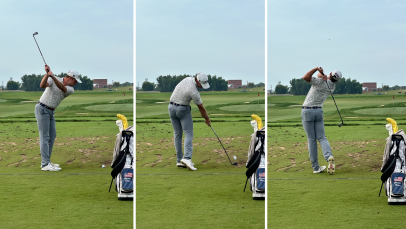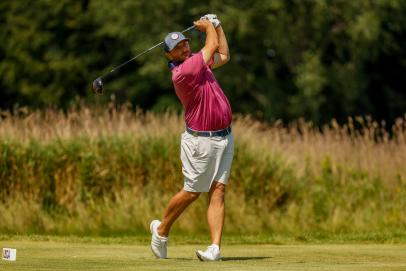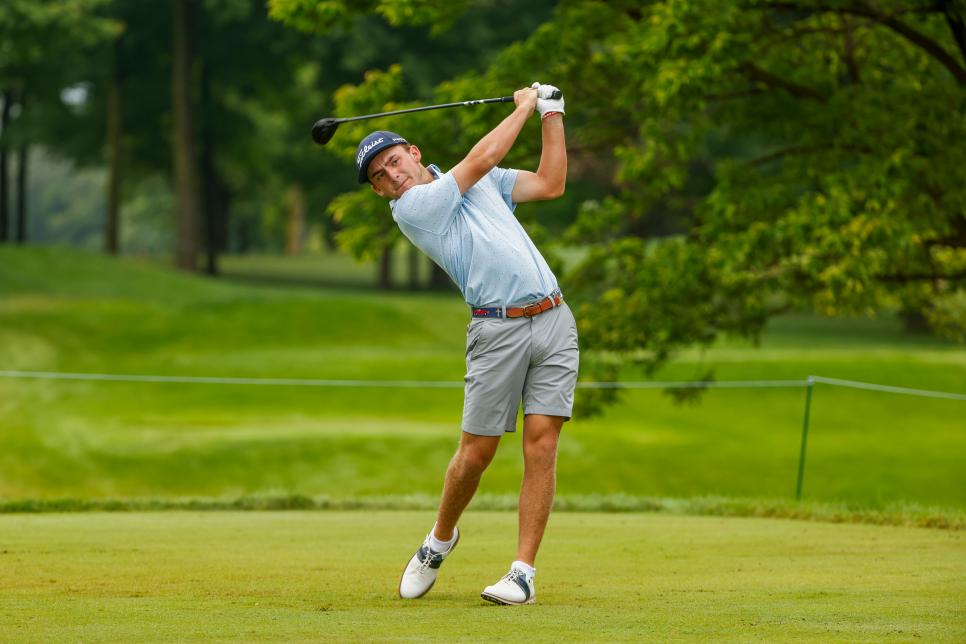Why this common aiming tool is hard to find at the U.S. Amateur – Australian Golf Digest

- by Admin
- August 15, 2024

CHASKA, MINN. — Go ahead, name the fundamentals of a good golf swing. How long did it take until you said alignment? Along with grip and posture, instructors and professionals have long preached consistent and proper alignment as essential to good ball-striking.
And essential to dialing in your alignment is using some sort of aid, whether it be a club on the ground or an alignment stick that is set parallel to your target. Alignment sticks have tons of fantastic uses, including checking where your feet and shoulders are aimed, dialing in your swing path and checking your ball position.
Yet, as match play is underway at the U.S. Amateur at Hazeltine National, where on Thursday the Rounds of 32 and 16 will determine who advances to the quarterfinals, a strange pattern is emerging on the range: Hardly anyone is using alignment aids while they are warming up.
It turns out there’s a couple reasons, and we can all learn from how these elite players are preparing for big matches.
No. 1: Keep the feel
Sam Weinman, Golf Digest’s Digital Editorial Director, recently wrote in his Low Net column that, after talking with major champions and sports psychologists, one key aspect to transferring your range game to the course is to embrace what you have that day. “The best warm-up is to always prepare to work with what you have,” he wrote.
One U.S. Amateur competitor who fully subscribes to this idea is 16-year-old Tyler Mawhinney, who was the last man in the field after winning the Canadian Amateur last week to earn an exemption. Like a lot of his fellow players in the field at Hazeltine, Mawhinney doesn’t use alignment sticks to warm up before a round.
More From Golf Digest  U.S. Amateur This mistake cost Tiger Woods the 2009 PGA. Why U.S. Amateur players are struggling with it again at Hazeltine
U.S. Amateur This mistake cost Tiger Woods the 2009 PGA. Why U.S. Amateur players are struggling with it again at Hazeltine  U.S. Amateur U.S. Amateur contender rides never-before-seen grip to marathon victory at Hazeltine
U.S. Amateur U.S. Amateur contender rides never-before-seen grip to marathon victory at Hazeltine  U.S. Amateur A 39-year-old just beat all the kids at the U.S. Amateur—no, he can’t believe it either
U.S. Amateur A 39-year-old just beat all the kids at the U.S. Amateur—no, he can’t believe it either
“For me, alignment’s a lot of feel,” said Mawhinney, who is a member of the first U.S. National Junior Team. “I don’t like to use them before my round because I just like to keep feeling what I’m feeling for that day.”
On the day of competition, Mawhinney isn’t concerned with whether he is technically perfect or aimed exactly where he thinks he is. That work is for separate practice sessions. When it’s time to warm up, it’s about getting comfortable with what he’s feeling at that moment, even if it’s not “correct.”

Tyler Mawhinney plays his tee shot on the fifth hole during his Round of 32 at the U.S. Amateur.
Chris Keane
“For example, for that day, say I have a right bias and I’m aimed 10 yards right. I’m just pulling it, but I can consistently do it,” he said. “It’s hard for me to make a confident swing when it feels like I’m aimed left. I know my body can compensate for that day, and then I try to fix it after that.”
As anyone who has used alignment aids can attest, often the correct aim feels bizarre if you’re not used to setting up properly. Mawhinney wants to avoid that awkwardness before a round. Instead, he trusts his body to compensate one way or the other if his alignment isn’t perfect. One key part to note, however, is that if his alignment is off during competition, he says he will be sure to use aids and dial it back in afterwards—just not right before a round.
No. 2: Randomize your warm up
The second reason many top players don’t use alignment aids when warming up for a round is that they are trying to randomize their warm-up. At Hazeltine, there are about 10 different greens with flags on the range, and players are constantly moving between them. In doing so, they are preparing for the fact that they won’t have two of the exact same shots in a row on the course.
Since they vary their aim and shot selection from shot to shot, using an alignment aid would not only slow down this process, but it would make their warm-up distinctly different from what they’ll experience on the course.
MORE: College golfer ends Jimmy Ellis’ Cinderella run at U.S. Amateur, inadvertently daggers him on way out
Scott Hamilton, one of Golf Digest’s 50 Best Teachers in America who teaches numerous players on the PGA Tour, says tour players do the same thing.
“There’s a few alignment stick guys out there, but not a lot of them on Thursday,” he said. “Most guys that are skilled players, by the time they get to Thursday, they’re just hitting balls.”
Hamilton says most players are intently focused on randomizing their practice to dial in their distance control. To do so, early in the week, players will often play a strokes-gained game available on Trackman.
“[Tom] Hoge played one yesterday, and it was 80 yards to 150, 20 shots,” he said. “It’s random. It shows you a green, it shows a circle on the green, it could be back right, front left, so you’re hitting the different areas of the green, it’s just a visual.” Hoge has long been one of the best iron players on tour and is currently ranked third in strokes gained/approach.
As Hamilton says, randomizing your practice is not only important when you’re warming up for a round, but during normal range sessions as well.
“Lots of guys are doing work on shot shapes,” he said. “Hoge does the Trackman game a bunch, and he cares about every shot he hits anyway, but he super cares about those because there’s a score.”
The takeaway is not to throw away your alignment aids, but instead learn when and when they shouldn’t be used. Remember that the best way to bring your range game to the course is to learn to embrace what you have that day. As players at the U.S. Amateur and on the PGA Tour demonstrate, that means mixing up your warm-up and getting comfortable with your feel, regardless of if it’s technically correct.
This article was originally published on golfdigest.com
The Latest News
-
January 10, 2025Australian Open: Iga Swiatek felt awkward making excuses for absence during doping ban
-
January 10, 2025’Worst time in my life’: World No. 2 opens up on drugs ban ahead of Australian Open
-
January 10, 2025Emma Raducanu dismisses fitness concerns in optimistic Australian Open verdict
-
January 10, 2025Emma Raducanu avoids drugs test concern just days before Australian Open after flare up
-
January 10, 2025Medvedev vying to steal two titles off young guns





